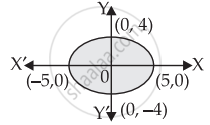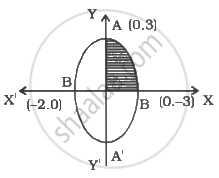Advertisements
Advertisements
Question
The area of the region bounded by the ellipse `x^2/25 + y^2/16` = 1 is ______.
Options
20π sq.unit
20π2 sq.units
16π2 sq.units
25π sq.units
Solution
The area of the region bounded by the ellipse `x^2/25 + y^2/16` = 1 is 20π sq.unit.
Explanation:
Given equation of ellipse is `x^2/25 + y^2/16` = 1
⇒ `y^2/16 = 1 - x^2/25`
⇒ y2 = `16/25 (25 - x^2)`
∴ y = `4/5 sqrt(25 - x^2)`
∴ Since the ellipse is symmetrical about the axes.
∴ Required area = `4 xx int_0^5 4/5 sqrt(25 - x^2) "d"x`
= `4 xx 4/5 int_0^5 sqrt((5)^2 - x^2) "d"x`
= `6/5 [x/2 sqrt((5)^2 - x^2) + 25/2 sin^-1 x/5]_0^5`
= `16/5 [0 + 25/2 * sin^-1 (5/5) - 0 - 0]`
= `16/5 [25/2 * sin^-1 (1)]`
= `16/5 [25/2 * pi/2]`
= 20π sq.unit
APPEARS IN
RELATED QUESTIONS
Make a rough sketch of the graph of the function y = 4 − x2, 0 ≤ x ≤ 2 and determine the area enclosed by the curve, the x-axis and the lines x = 0 and x = 2.
Sketch the graph y = | x + 1 |. Evaluate\[\int\limits_{- 4}^2 \left| x + 1 \right| dx\]. What does the value of this integral represent on the graph?
Find the area of the region \[\left\{ \left( x, y \right): \frac{x^2}{a^2} + \frac{y^2}{b^2} \leq 1 \leq \frac{x}{a} + \frac{y}{b} \right\}\]
Draw a rough sketch of the region {(x, y) : y2 ≤ 5x, 5x2 + 5y2 ≤ 36} and find the area enclosed by the region using method of integration.
Prove that the area in the first quadrant enclosed by the x-axis, the line x = \[\sqrt{3}y\] and the circle x2 + y2 = 4 is π/3.
Prove that the area common to the two parabolas y = 2x2 and y = x2 + 4 is \[\frac{32}{3}\] sq. units.
Find the area of the region in the first quadrant enclosed by x-axis, the line y = \[\sqrt{3}x\] and the circle x2 + y2 = 16.
Find the area bounded by the curves x = y2 and x = 3 − 2y2.
Make a sketch of the region {(x, y) : 0 ≤ y ≤ x2 + 3; 0 ≤ y ≤ 2x + 3; 0 ≤ x ≤ 3} and find its area using integration.
Find the area enclosed by the curves 3x2 + 5y = 32 and y = | x − 2 |.
Find the area enclosed by the parabolas y = 4x − x2 and y = x2 − x.
The area bounded by the curve y = loge x and x-axis and the straight line x = e is ___________ .
The area bounded by the curve y = f (x), x-axis, and the ordinates x = 1 and x = b is (b −1) sin (3b + 4). Then, f (x) is __________ .
Find the coordinates of a point of the parabola y = x2 + 7x + 2 which is closest to the straight line y = 3x − 3.
The area enclosed by the ellipse `x^2/"a"^2 + y^2/"b"^2` = 1 is equal to ______.
Find the area of the region bounded by the curve y2 = 4x, x2 = 4y.
The area of the region bounded by the y-axis, y = cosx and y = sinx, 0 ≤ x ≤ `pi/2` is ______.
The area of the region bounded by parabola y2 = x and the straight line 2y = x is ______.
Using integration, find the area of the region bounded between the line x = 4 and the parabola y2 = 16x.
Find the area of the region bounded by the ellipse `x^2/4 + y^2/9` = 1.
The area bounded by the curve `y = x|x|`, `x`-axis and the ordinate `x` = – 1 and `x` = 1 is given by
Find the area bounded by the curve y = |x – 1| and y = 1, using integration.
Using integration, find the area of the region bounded by the curves x2 + y2 = 4, x = `sqrt(3)`y and x-axis lying in the first quadrant.
Find the area of the region enclosed by the curves y2 = x, x = `1/4`, y = 0 and x = 1, using integration.
The area of the region S = {(x, y): 3x2 ≤ 4y ≤ 6x + 24} is ______.
Area (in sq.units) of the region outside `|x|/2 + |y|/3` = 1 and inside the ellipse `x^2/4 + y^2/9` = 1 is ______.
Let f : [–2, 3] `rightarrow` [0, ∞) be a continuous function such that f(1 – x) = f(x) for all x ∈ [–2, 3]. If R1 is the numerical value of the area of the region bounded by y = f(x), x = –2, x = 3 and the axis of x and R2 = `int_-2^3 xf(x)dx`, then ______.
Let g(x) = cosx2, f(x) = `sqrt(x)`, and α, β (α < β) be the roots of the quadratic equation 18x2 – 9πx + π2 = 0. Then the area (in sq. units) bounded by the curve y = (gof)(x) and the lines x = α, x = β and y = 0, is ______.
Find the area of the following region using integration ((x, y) : y2 ≤ 2x and y ≥ x – 4).
Hence find the area bounded by the curve, y = x |x| and the coordinates x = −1 and x = 1.
